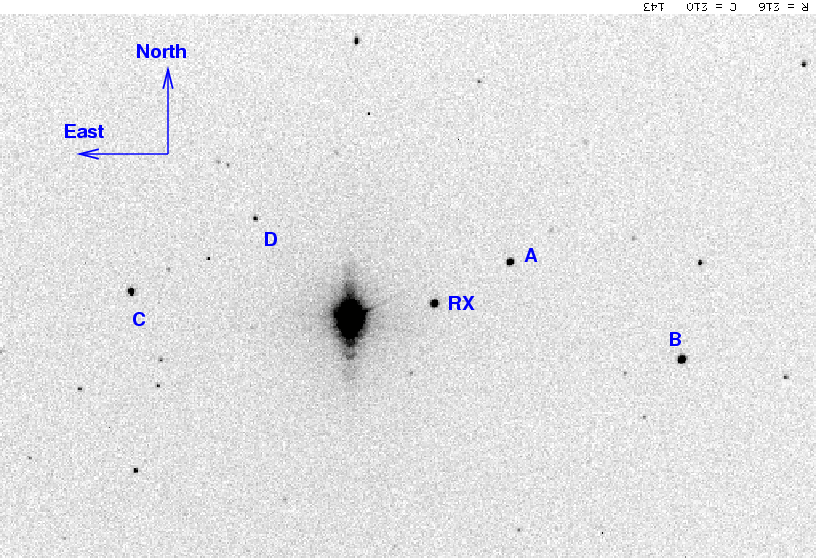
On the night of June 24/25, 2009, I observed the cataclysmic variable star RXJ1643+34 = V1084 Her. Joe Patterson of the Center for Backyard Astrophysics suggested that members of the CBA observe this star during the summer. The object is at RA = 16:43:45.70 Dec = +34:02:40, so it is placed near the meridian at sunset.
The setup was:
Notes from the night
This is a chart of the field taken from the DSS.

The chart has several of the brighter stars in the field labelled with letters, just to keep me straight as I perform the reductions. Star A is photometry provided by Mickaelian et al., A&A 381, 894 (2002):
my label RA Dec B V ---------------------------------------------------------------------------- A USNOB1.0 1240-0246555 16:43:40.59 +34:03:02 13.51 12.97 B TYC 2585-1631-1 16:43:27.81 +34:02:07 13.20 12.16 ----------------------------------------------------------------------------
I measured the instrumental magnitude of each star with aperture photometry, using a radius of 4 pixels = 5.6 arcseconds and sky defined by an annulus around each star. Following the procedures outlined by Kent Honeycutt's article on inhomogeneous ensemble photometry, I used all stars available in each image to define a reference frame, and measured each star against this frame.
One output of the ensemble solution is the value of the zero-point of each frame relative to the others. In the graph below, I plot this zero-point as a function of time. Note the bumps -- they are due to clouds passing overhead. I removed one stretch of images due to the clouds.
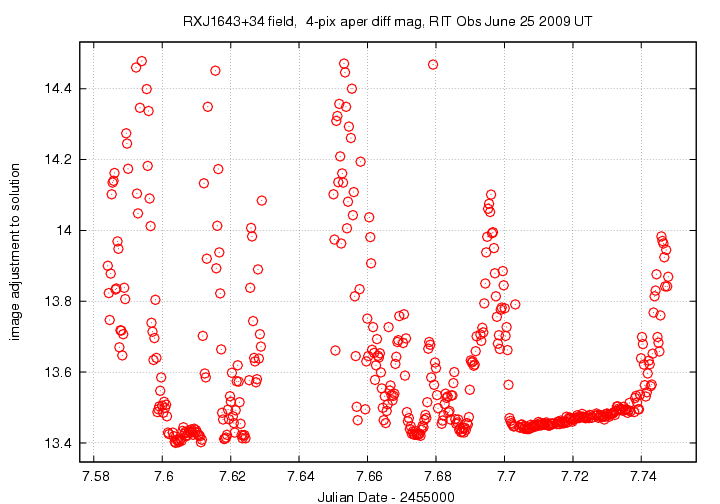
Note how well the times of high zero-point, in the graph above, match the times when fewer objects were detected, in the graph below.
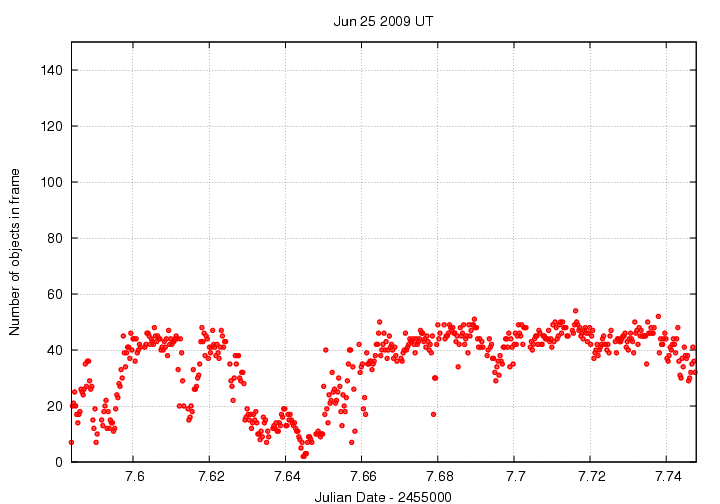
Below is a graph of the scatter in differential magnitude versus magnitude in the ensemble solution.
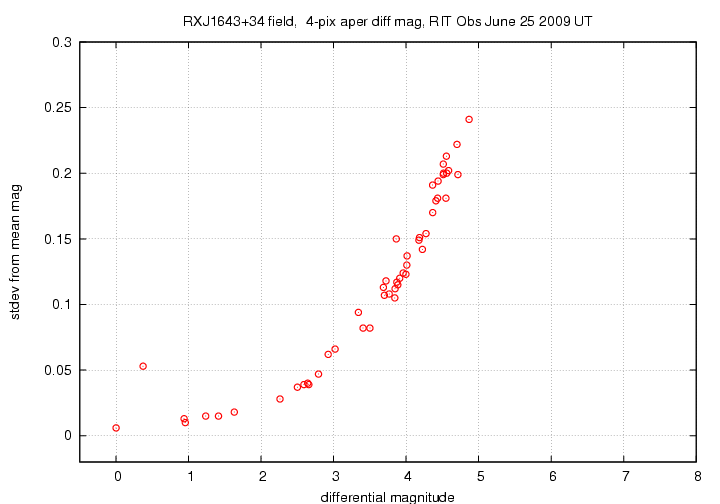
The floor of this diagram corresponds to a scatter of about 0.008 mag. RXJ1643 appears at differential magnitude 0.4; its scatter of 0.050 mag is much larger than that of other bright stars. showing that it is a variable.
Light curves for selected stars (RXJ1643 and stars A - D) in the field are shown below. The target is shown by light green crosses. I've shifted star "C" (pink squares) a bit to separate it from star "A" (red plus signs).
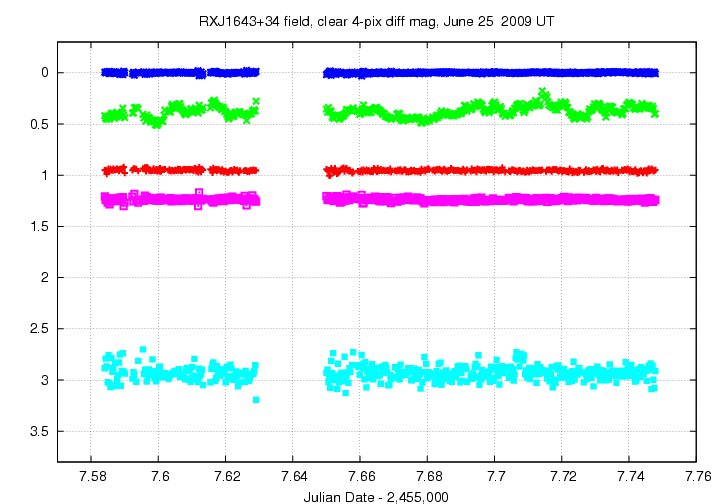
Here's a closeup of the variation in RXJ1643 and a few comparison stars.
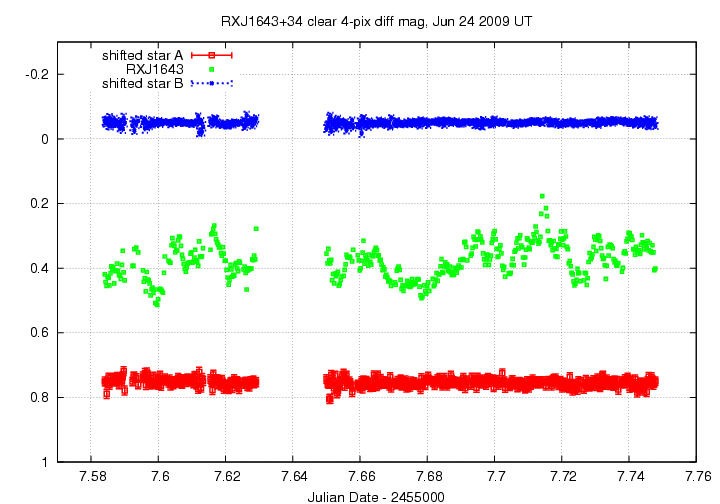
I've made a table of the measurements themselves, with three different flavors of time. The differential magnitudes from the ensemble solution have been shifted so that star "A" in my chart, USNOB1.0 1240-0246555, has value 12.97.
Here's the start of the table.
# Measurements of RXJ1643+34 made at RIT Obs, Jun 25, 2009 UT, # by Michael Richmond, using 12-inch Meade LX-200 and SBIG ST-8E CCD. # Each exposure 15 seconds long with no filter. # Tabulated times are midexposure (FITS header time - half exposure length) # and accurate only to +/- 1 second (??). # 'mag' is a differential magnitude based on ensemble photometry # using a circular aperture of radius 5.6 arcseconds. # which has been shifted so USNOB1.0 1240-0246555 has V=12.97 # to match value from Mickaelian et al., A&A 381, 894 (2002) # # UT_day JD HJD mag uncert Jun25.08410 2455007.58410 2455007.58691 12.434 0.011 Jun25.08438 2455007.58438 2455007.58719 12.458 0.010 Jun25.08465 2455007.58465 2455007.58746 12.470 0.010
Last modified 6/25/2009 by MWR.